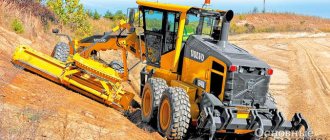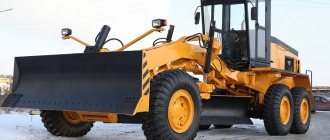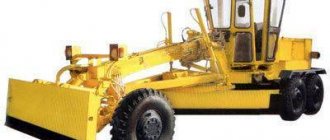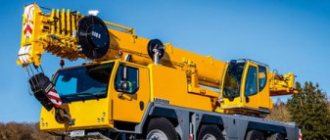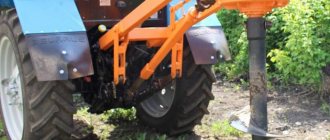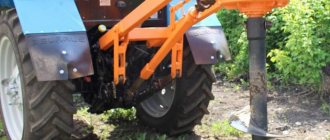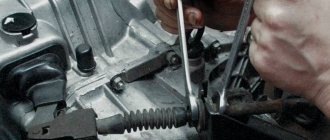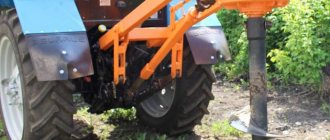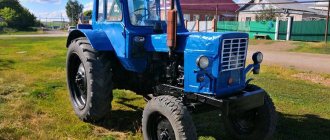A grader is a productive special equipment capable of efficiently and quickly performing a wide range of excavation, construction and transportation tasks. Such machines are actively used in the construction and maintenance of highways and airfields. With the help of graders, they carry out planning and profiling of areas and slopes, layer-by-layer leveling of soil and other bases. They are also indispensable when creating roadsides, excavations and embankments, and clearing areas of snow and building materials. The grader is an excellent assistant in the construction of railway, hydraulic, irrigation, land reclamation and other structures.
Foreign brands
The first motor grader was developed in 1919 by Russell (USA), which used Caterpillar tractors as tractors (before that, similar machines were horse-drawn). In 1928, Caterpillar purchased the Russell, and a few years later a completely redesigned and modernized grader with a 40-horsepower engine appeared, which became the forerunner of the company's modern products. Today's Cat M3 Series can be considered the industry standard, both because of history and the innovation and technology that the company has been implementing over the past 80 years. Electronically adjustable control handles help the operator work tirelessly at their best (levers are a thing of the past), and features like return-to-center articulation make work easier.
More powerful than their predecessors, models 12M3 (weight 19,344 kg, power 179 hp, blade width 3.7 m), 140M3 (weight 19,935 kg, power 200 hp, blade width 3.7 m) , 160M3 (weight 20,660 kg, power 221 hp, blade width 4.2 m) and their all-wheel drive versions are ready to perform any task. Thanks to the high torque, smooth operation is achieved with a sharp short-term increase in load. The hydraulically driven cooling fan speed is automatically adjusted based on engine temperature. The sealed front axle axle is in an oil bath, and the roller bearing is installed on the outside, which increases its service life. Multi-disc service brakes in an oil bath have now become a standard for any serious equipment; the M3 has all the wheels of the rear bogie with their own brakes. Different flow rates for the piston and rod cavities of the hydraulic cylinder are ensured using electro-hydraulic compensating valves, which improves the response of the working equipment.
Simultaneous operation of the working bodies “without losses” and without reducing engine speed is ensured due to the proportional flow rate of hydraulic fluid. Operators will note a comfortable workspace with well-functioning heating and ventilation. Additional LED lights in the engine compartment make the grader easier to maintain in low light conditions. The factory-installed adjustable grade control system automatically controls one side of the blade using grade sensors, ultrasonic and laser sensors, and GPS. Using another built-in system, you can track the location of the machine, the nature of the work and the condition of the equipment in real time.
Volvo family of self-propelled graders includes four models with the D7 engine and three models with the D9 engine. The offered models are characterized by high performance and flexibility in operation. The product line includes five tandem drive self-propelled graders: G930, G940, G960, G970 and G990, as well as G946 and G976 all-wheel drive graders. The cars meet European standards for emissions and noise. Widely spaced blade lift cylinders and a side shift cylinder with low operating angles ensure blade stability. The hydraulic system with proportional flow distribution depending on the load, in combination with an automatically controlled blade, trolling pedal and a circle turning system with two drive gears, allows for increased sensitivity of control of the implement. The number of work steps per pass increases, and high precision movements help reduce costs. At the customer's request, a transmission with an extended speed range can be installed, which will provide high control efficiency in the lower range, optimal travel speed in the upper range, flexibility in the operating range and additional fuel economy. An automatic transmission mode is available.
The design of the machine is designed for long, trouble-free operation. To reduce wear, the turntable bearings are made of high-strength polymer material. The original heavy-duty frame hinge is safe for hydraulic hoses. The key elements of the all-wheel drive system of Volvo motor graders are two variable displacement axial piston pumps that directly drive the wheel motors. The performance of the pumps is adjusted depending on the selected operating mode, which allows you to precisely control the transfer of power to the wheels. The system does not require the installation of a flow divider valve and ensures efficient power transfer from pumps to motors with minimal losses. The display in the grader cabin provides detailed information about the current status of the machine. In addition, the system records and can store 25 operating parameters for subsequent analysis. With all the benefits of a joystick, old-school operators will be able to choose a machine equipped with levers.
John Deere graders' new distinctive high-clearance frame design increases turntable clearance and blade work area and makes it easier to rotate the blade into cutting position. The event-based programming (EBS) transmission measures engine load as well as other inputs for optimal smooth shifting each time the operator selects a new gear. Among the features, we can also note high-strength tapered roller bearings in the articulated joint, as well as self-lubricating bearings in other main components.
The automatic differential lock remains engaged when driving in a straight line, is switched off when cornering in excess of 10°, and is switched on again when returning to the straight line. Automated cross-slope traversing makes it easier to maintain stable slope control by performing the job with just one lever. The operator simply selects the desired slope and side of the blade to be controlled manually. Once installed, the system automatically adjusts the opposite blade lift cylinder to maintain grade. Leveling control buttons are integrated directly into the control levers. The activation of auxiliary functions is carried out using mini-levers, which are located on the right armrest, and large paired levers that control the main mechanisms. You can control the car using one of the levers on the left armrest or a regular steering wheel. Return to straight line automatically straightens the articulated frame at the touch of a button.
From the presented brief overview it is clear that global brands, as they say, “go shoulder to shoulder”, quickly introduce the latest technologies, trying to present to the market not just a grader, but a machine with outstanding capabilities. Chinese products in the grader segment are also quite widely represented. Up to half of imported cars today arrive on the Russian market from the Middle Kingdom. The bulk of our cars are sold under the XCMG brand. This is not surprising, since graders from Xuzhou and in their homeland are the undisputed market leaders. Of course, the level of Chinese manufacturers is still far from that of companies in developed countries, nevertheless, this equipment finds its consumer in Russia.
The light grader GR135, medium-class models GR165, GR180 and GR215 with hydromechanical transmission are equipped with Chinese-made Cummins engines, Xuzhou-Meritor axles (PRC-USA) and Chinese gearboxes. Like all Chinese special equipment, these are fairly simple machines with lever control and without any electronics. The only all-wheel drive model is the GR215A, which is also already well known in Russia. Other manufacturers from China produce similar models that differ little in configuration. Among the most famous in our country are Liugong and Tiangong.
This is interesting: OKVED for rental services of special equipment
SEM922. Precision grading solutions
Photo source: www.semmachinery.com
Weight: 18,270 kg Power: 162 kW
The all-wheel drive SEM922 is one of the brand's most popular motor graders. It is worth noting that the company’s lineup also includes two large vehicles and vehicles without all-wheel drive.
One of the features of this grader is Caterpillar's PPPC hydraulic system, which reduces cycle time and improves control accuracy of work equipment. The first is achieved due to the ability to combine differently loaded functions, the second - as a result of the fact that the speed of cylinder extension does not depend on the engine speed (which means that the operator always knows what to expect from the system).
Separately, it is worth mentioning the axles developed by SEM specialists: maintenance-free tandem chains are provided, the oil change interval is increased to 2,000 hours.
Photo source: www.semmachinery.com
The SEM922 is equipped with a Chinese ShangHai Diesel (SDEC) SC9D220G2 engine and a HangChi 6WG180 transmission (multi-shaft, Powershift type, allows smooth gear shifting even under load). In addition, components from American brands are used: Eaton rear axle differential, Parker axial piston hydraulic pump, Poclain front-wheel drive motors and Sauer Danfoss front-wheel drive pumps.
The basic configuration of the machine includes a whole set of wearable and easily replaceable or adjustable spacers installed to reduce wear on the main operating units of the motor grader. Additionally, you can install a slip clutch (protects the teeth and drive mechanism of the turntable in the event of the edge of the blade hitting an obstacle on the road) and a hydraulic locking of the position of the blade link (with it it is much easier to change the position of the blade).
The buyer can choose the best working equipment for his needs, including a front blade and ripper with 3 or 5 teeth, a 9-tooth pick and a snow wing for clearing roads. Also available as an option is the installation of two batteries of increased capacity, a winter starter, an auxiliary cold start device on ether and an engine oil heater.
Classification of motor graders
By wheel type:
- On metal wheels. Such models will cost less, they are simpler and do not require expensive maintenance. A significant disadvantage of such graders is their low speed - 5-6 km/h.
- On pneumatic wheels. This type of grader is more expensive, and maintenance is somewhat more difficult, but they are more powerful and can move under their own power at speeds of up to 30 km/h.
By weight and power of the motor grader:
- Lungs. The mass of such machines is 9-12 tons, and the power is 75-90 horsepower. They are used primarily for planning, marking, and patrolling;
- Average. Weight 13-15 tons, power 120-150 hp. Such models are used mainly for reconstruction, road profiling, as well as mixing materials on site;
- Heavy. The weight of motor graders of this type is 19-20 tons, the power is 250-300 hp. The main scope of application is the construction of asphalt and earthen roads.
By transmission type:
- With manual transmission. This type of transmission provides for stepwise and manual changes in the speed of the vehicle;
- With hydromechanical transmission. Automatic and smooth regulation of vehicle speed.
By type of final drives:
- Final drive (for light and medium type motor graders);
- Separate drive axles (heavy vehicles are equipped with them).
Based on the type of frame, motor graders are divided into:
- Models with a rigid frame are more durable, but less maneuverable;
- Models with an articulated frame - such machines are more maneuverable and can perform a wide range of work.
Caterpillar
Photo 1: Cat 140M Motor Grader
Caterpillar (known as Cat) is one of the international leaders in specialty machinery and equipment for the construction industry. This is the oldest and most famous grader brand, having actually existed since 1903, when American engineers Richard Russell and Charles Stockland began producing their first graders (with early models often coupled with Caterpillar tractors). In 1928, Caterpillar acquired the Russell Grader Manufacturing Company and became the market leader. Since then, the company has worked its way to the very top of the international market, and maintains this position to this day, due to the introduction of modern electronics and hydraulics, as well as optimal performance.
In Russia, this brand is represented mainly by products of two series: R and H, but it is the M-series that is by far the most technically advanced. The range includes more than a dozen grader models with power from 92 to 367 kW. Caterpillar units feature a direct drive transmission with automatic overload shifting using patented technology. Another feature of Caterpillar models is a specially designed wheel adjustment system, thanks to which they do not slip in low gears.
Which one is better to buy: Russian-made M-series devices include the following models: 140M, 12M, 14M, 16M and 18M.
Best Offer - Caterpillar 140 and 140M3
Photo 2: 140M3 motor grader
When it comes to universal automatic graders for road construction from Caterpillar, it is best to pay attention to the new products that are located at the top of the ranking of quality graders: 140 or 140M3. One of the main differences between the two models is their control methods: the 140M has a steering wheel and control levers, while the 140M3 has joysticks. They also have high-quality technical solutions to improve productivity.
Description: The operating weight of the 140M is 19.1 tons, and the engine power is 250 horsepower. While the 140M3 has a weight of 20 tons and an engine with a capacity of 252 horsepower.
Caterpillar is seeing growing customer interest in automatic grade control systems. Therefore, the joystick-controlled 140M3 includes auto-articulation.
In recent years, Caterpillar has focused on reducing operator fatigue by improving seat comfort, line of sight, heating and air conditioning, and control systems. The operator cabin can be equipped with a radio, Bluetooth, phone charger and other gadgets. All this is designed to make the operator’s work as easy as possible and create comfortable working conditions for him.
Advantages
So why should you consider Cat graders? Here are a few key features of their latest M series:
- Devices of this type have engines with a power of 129 and 387 kW, good ergonomics and controls.
- The Cross Slope system gives you more precision and control over your grader and allows operators to grade faster. It allows you to control the transverse slope of the surface.
- Models in this series are able to detect blade kickback and quickly stabilize.
- Comfortable controls provide better productivity and help reduce operator fatigue.
- Advanced joystick controls give you complete control over your grader. Switching, turning, blade adjustment, hydraulic control and much more are all done through one interface.
Flaws:
- There are no significant ones.
Grader (motor grader), types, types, classes, its working equipment, application and characteristics.
Grader is a trailed or self-propelled wheeled machine with an adjustable blade located between the front and rear wheels that cuts, moves and distributes material, usually for grading purposes.
Grader (motor grader)
Working and auxiliary equipment of the grader (motor grader)
Types, types and classes of graders (motor graders)
Grader (motor grader) parameters
Application of a grader (motor grader)
Other road construction equipment: asphalt paver, bulldozer, grader, scraper
Application area:
The main areas of application of graders are the road construction industry, agriculture, public utilities, construction and maintenance of airfields. In the road construction industry, they are used for leveling road bases and constructing roadbeds using lateral reserves (in slightly rough and flat areas with an embankment height of less than a meter). Graders carry out layer-by-layer leveling of soil after the work of earth-moving machines; with their help, drainage channels, slopes, shoulders, excavations and embankments are equipped. Graders are widely used in the repair of gravel and dirt roads, in irrigation and land reclamation, and for clearing streets and roads of snow.
Information taken from the site
Leading motor grader manufacturers
Volvo Construction Equipment. Price – from 3 million rubles. The history of this company began in 1997, when Volvo Construction Equipment acquired the Canadian company Champion Road Machinery Ltd., which had been producing motor graders for many years. In 2000, a new generation of graders came out under the name Volvo. Now there are 2 series: compact graders and medium (heavy) machines of the B series. Compact models are equipped with 4-liter Cummins diesel engines and hydrostatic transmission. Speed range - from 0 to 32 km/h, frame - articulated. Heavy models are equipped with 6-cylinder diesel engines with a volume of 7.1-9.6 liters with turbocharging, electronic injection and intercooling. Automatic transmission, hydrostatic transmission, wide range of additional equipment.
photo: Volvo motor grader
Caterpillar Inc. The cost of equipment is from 380 thousand euros. This company is a fairly well-known manufacturer of specialized equipment. Motor graders are simple, productive and easy to maintain. The lineup includes 9 models of varying power and performance. Most models are equipped with 8-speed electronically controlled gearboxes, powerful engines, hydrostatic transmission, and an extended wheelbase has made the model more productive. In travel mode, motor graders can reach speeds of up to 40 km/h. The basic package can be supplemented with a variety of additional equipment.
photo: Motor grader Caterpillar Inc.
CNH (Case—New Holland). This corporation has three model ranges of motor graders; they are produced under the brands Case, O&K, FIAT-Kobelco. Graders are medium and heavy, as well as one light one with all-wheel drive. The configuration depends on the model range: Cummins diesel, with a volume of 5.9 to 7.5 liters; for heavy models, 8.3 liter engines with a power of 155 kW, equipped with turbocharging, are provided. The transmission has 8 forward gears and four reverse gears, the frame breaks at an angle of 25-28 degrees. Additional equipment includes rippers, counterweights, blade extensions and other elements.
photo: CNH motor grader (Case-New Holland)
Komatsu. Prices start from 2.5 million rubles and above. The Japanese manufacturer presents 2 model ranges of motor graders on the market under the Galion and Komatsu brands. Most cars are equipped with 6-cylinder Komatsu turbocharged diesel engines, their power varies from 104 to 210 kW; for the heavy model they install a Cummis engine with a power of 168 kW and a volume of 10.8 liters. Hydromechanical gearbox, overload protection, precise movement pedal, a reversible gearbox has been specially created for heavy models. The maximum forward speed is 45 km/h, reverse – 47.9 km/h. Galion are medium motor graders, their engine power is 107-152 kW. Additionally, there is a wide choice of configurations.
photo: Komatsu motor grader
American and Japanese manufacturers are significantly ahead of domestic ones, but they are also much more expensive. Chinese analogues are also appearing on our markets, the most famous being XCMG, LongGong CDM, Changlin, Shantui Construction Machinery and others. In terms of cost, they are comparable to motor graders produced at the Chelyabinsk Road Construction Machinery Plant or the Bryansk Arsenal, but they are superior in functionality to Russian equipment.
The choice of motor graders is really large; you need to focus not only on the brand’s popularity, but also on the characteristics presented, the proximity of service centers, the ability to buy spare parts and other practical nuances. We hope our article will make your task a little easier!
On our website you can find advertisements for the sale and rental of motor graders in the Buy a motor grader and Rent a motor grader sections, respectively.
This page has been viewed 14538 times, published on 11/17/2014
How to choose
Choosing the right motor grader for road construction depends on many factors, depending on your selection criteria. Overall it really comes down to the amount of work, the soil material, the cost of the product. Therefore, different characteristics are important for each buyer, which depend on the region and the nature of the work.
But when it comes to transporting large quantities of material for a major road job, power and torque are at the forefront. And here you should turn to leading international manufacturers such as Caterpillar, John Deere, Komatsu, Volvo, or domestic RM-Terex and Bryansk Arsenal OJSC - they all produce powerful and productive machines that are suitable for different categories of consumers.
It is recommended to look at customer reviews and recommendations, and not judge by the popularity of models. A common mistake when choosing a grader is choosing the most expensive and productive device, without taking into account the characteristics.
Working and auxiliary equipment of the grader (motor grader):
The main components of the grader are the basic wheeled transport vehicle and the main working equipment - a blade , as well as auxiliary (additional) working equipment - a pick, ripper, snow plow, front blade, bulldozer blade, swept blade, slopes, extensions, etc.
The blade is the main working part of the grader, which distinguishes it from other types of road construction equipment. The blade is a rectangular sheet with some radius bend. The blade can be positioned at different angles in the horizontal and vertical planes relative to the longitudinal axis of the base transport vehicle, and can also be carried out and pulled to the side. It can rise, fall and rotate in horizontal and vertical planes.
Blades of all types of graders are equipped with mechanisms with a hydraulic or mechanical drive for raising and lowering the blade, turning in two planes, distortions in the transverse plane, and tilting back and forth along the way. The blade is attached to the traction machine with a rotating mechanism and a traction frame.
Knives are attached along the bottom and side edges of the blade, respectively called the bottom knife and side knife.
Picker - auxiliary equipment in the form of a frame with removable teeth (7-11 teeth) for loosening the soil, destroying road pavements and coatings during road repairs. The pickaxe can be installed in front of the front wheels of the motor grader or between the front and rear wheels.
Ripper is an additional equipment consisting of a frame connected by means of mounting brackets to the rear of the base machine, and equipped with one or more teeth. Ripping equipment is installed not only on motor graders, but in many cases also on bulldozers and tractors.
Snow plow - a structure located in front of the front wheels and designed to move snow in the transverse direction due to the plowing action of the blade. The plow can be single-bladed or double-bladed.
Front Blade - A blade, usually with a curved surface, located in front of the front wheels and designed to rake and push material, usually in a forward direction.
Motor graders are also equipped with automatic leveling systems in order to speed up work operations and obtain surfaces with strictly defined parameters.
Motor graders can be equipped with a remote control system.
This is interesting: Preparing an excavator for work - operating instructions
XCMG GR2153A. Modern budget car
Photo source: xcmg-ru.ru
Weight: 16,100 kg Power: 164 kW
The XCMG GR2153A all-wheel drive motor grader is equipped with a Cummins QSB6.7 turbocharged engine and a Liuzhou ZF 6WG200 gearbox. High power is achieved thanks to increased torque when operating at low speed. The engine capacity is 6.7 liters, the maximum tractive effort is 113.8 kN.
The design of the machine uses components from well-known world manufacturers: in addition to the already mentioned brands, these are SAUER (USA), SAMPO (Finland), etc. The drive axle is of our own production.
Let us take a special look at the hydraulic system of the machine. The designers have achieved a 20% higher operating speed of hydraulic cylinders. In addition, thanks to the increased pressure in the hydraulic system, which significantly increases the rotation force, and the installation of a high-frequency hardened gear, operations such as rotation under load can be performed.
Photo source: xcmg-ru.ru
To enhance safety, the XCMG GR2153A is equipped with a fully hydraulic braking system. What makes the machine maneuverable is the patented front axle with a large steering angle, combined with an articulated frame (this allows the motor grader to be turned at a small radius).
The manufacturer also took care of operator comfort: air conditioning is provided as standard, and vibration levels have been reduced due to the six-point mounting of the cab. For easier access to the engine, a rear hinged hood with hydraulic lift is provided. Operating temperature of the machine: from -40 to +50 degrees.
For this model, in addition to blades (front and middle) and a ripper, a front pick and a V-shaped snow shovel are available. The optimized grader blade (its width is 4,270 mm) allows you to quickly turn and dump soil and thus achieve optimal load distribution and minimal accumulation of material in the turntable area.
Options for this machine include multi-disc wet brakes, a rear view camera, tubeless tires, the Moba automatic leveling system, etc.
Prospects for the development of graders
In recent years, the following trends have emerged in the development of motor grader design:
- increasing engine power without significantly increasing the weight of motor graders;
- introduction of hydromechanical transmissions for the chassis of the vehicle: the use of engines adapted to operate at significant rolls, as well as in conditions of low and high temperatures and high dust levels in the air;
- increasing the transport speed of graders;
- automation of control in order to ensure automatic profiling along a given profile - leveling system;
- significant improvement in driver working conditions;
- use of low-pressure tires with centralized regulation of air pressure supplied from the engine compressor.
Return to list of articlesNext article
Excavator Big Muskie
The largest walking excavator with a 4250W bucket worked for 30 years in the USA. It was created by the Bucyrus Erie Company in 1969. The 13,500-ton giant reached a height of 68.7 m, a width of 46.2 m, and a length of 148.6 m. A 230-ton bucket, placed on a 95-meter boom, raked in 168 m3 of cargo in one cycle. On average, per month the machine transported 2.3 million m3 of rock in the open-pit mine.
This excavator moved on 20-meter support shoes with the help of four lifting hydraulic cylinders and transverse motion cylinders with a stroke of 4.2 m. In 1999, its service life came to an end, and the owners decided to dismantle the excavator. To remove the boom, 127 mm ropes had to be blown up. Now all that remains of Big Muskie is the bucket, which has turned into a museum exhibit.
The article was published in the magazine Grader No. 5 2014
Home / Special equipment / TOP largest types of special equipment
Trailed and semi-trailer units - what are the differences?
In a trailed grader, a traction frame with a rotating circular mechanism and a blade are mounted between the front axle and the rear axle on the main frame. The wheel axle is connected to the tractor's towing bracket by a drawbar. The operator controls the installation of the blade using a steering mechanical drive or levers of the spool device of the hydraulic system.
Figure 1 Trailed grader with driver steering control
A semi-trailer grader usually does not have a front axle and the length of the machine is shorter. The main frame is connected to the tractor hitch via a ball joint assembly. The hydraulic drive of the blade installation is controlled by the operator of the traction tractor.
Both units are towed by a tracked or wheeled tractor. The cost of towed devices is significantly lower than their self-propelled counterparts.
Figure 2 Tractor T-150 and semi-trailer hydraulic grader SD-105A
The trailed grader is structurally complex and ineffective in use. The disadvantage is that, in addition to the tractor driver, the operator of the unit controls it. Similar machines with a steering mechanism for mounting the blade are no longer produced and have been replaced by more productive semi-trailer graders with hydraulic drive of the executive equipment, controlled by the tractor operator:
- SD-105A for traction tracked and wheeled vehicles DT-75, T-150K, K-701;
- DZ-168 for the T-150K tractor.
Blade, traction frame.
The range of positions of the blade becomes wider: it is able to rotate 360º, take a vertical position up to 90º, and extend laterally beyond the line of the wheels.
Another aspect that is under the attention of modern motor grader developers is the geometric parameters of the blade and the design of the traction frame. For example, with the correct choice of cutting edge inclination angles and blade radii, the cut soil layer will be rolled into a roll earlier, and the force of resistance to the blade will be less. This means that the motor grader will move more smoothly when cutting soil and will spend less power (and, accordingly, fuel) on this work.
Some manufacturers have recently begun to position the traction frame slightly higher, which increases the space between the top edge of the blade and the bottom of the turntable and reduces the likelihood of these parts being blocked by sticky soil deposits in the gap.
Cost of equipment
Like any special equipment, graders are not cheap. For example, a new DZ 98 will cost approximately 8 million rubles. Used ones can be found from 1.5 million and even cheaper - but in this case the question arises about their technical condition.
When choosing a motor grader, it is recommended to focus not on price, but on performance indicators. There's little point in having an inexpensive machine that won't be able to do the job it's supposed to do. Therefore, first of all, you need to estimate what types of work the machine will perform, on what soils and in what operating mode it will be used.
Often, after calculating how much a grader costs, entrepreneurs decide to rent it. An excellent option for one-time work, but for seasonal maintenance of the territory it is still more profitable to buy special equipment or lease. The advantage of this option is that you can rent out your own equipment and thus speed up its payback.
Control
The motor grader is controlled from an all-metal cabin. Control devices are located on a panel under the roof. The sprung seat and steering column are adjustable to suit the operator's height.
The cabin is equipped with ventilation and heating devices. All-round glazing and lighting fixtures provide sufficient visibility of the grading area.
The gearbox is switched by a lever, the front wheels and actuators are controlled by hydraulics, and the wheel brakes are controlled by pneumatics.
